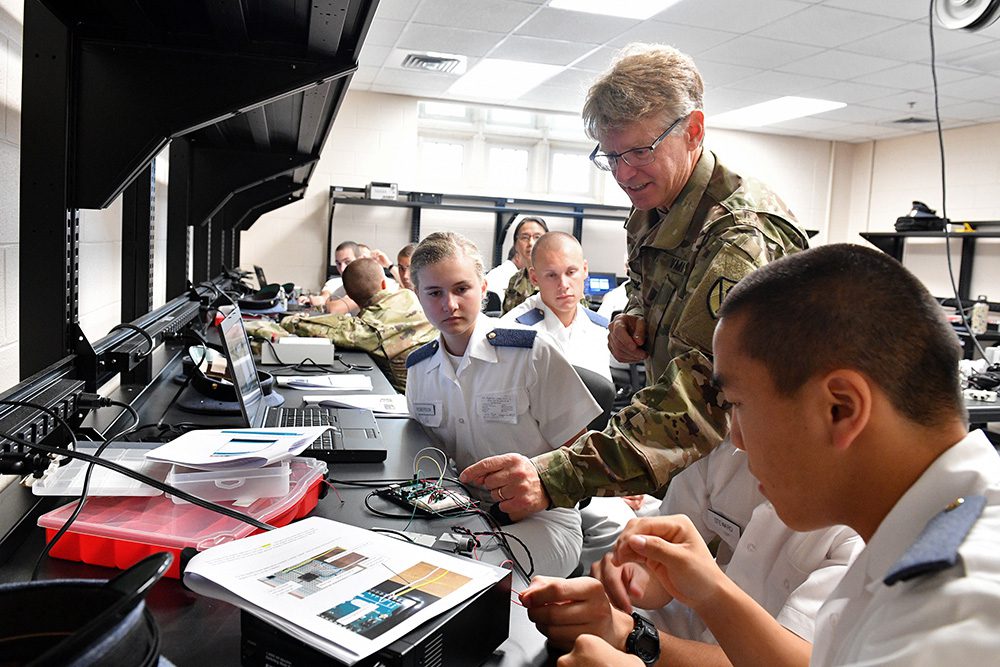Cornerstone Lab Continues to Engage Cadets

Cadets watch as Col. Jay Sullivan, professor of mechanical engineering, shows them the circuitry for an Arduino microcontroller. VMI photo by Kelly Nye.

Cadets watch as Col. Jay Sullivan, professor of mechanical engineering, shows them the circuitry for an Arduino microcontroller. VMI photo by Kelly Nye.
Four years ago, the Department of Mechanical Engineering began a new initiative to help rats majoring in that discipline connect to the fun and challenge of engineering from their first semester on post. Dubbed the cornerstone lab, the initiative’s goal was to engage mechanical engineering majors from the start with hands-on projects, so they’d be less likely to switch majors down the road.
Results have been mixed: 4th Class cadets do seem to be staying in the major into their 3rd Class year, but the overall number of mechanical engineering majors graduating is holding steady, according to Col. Gerald “Jay” Sullivan, Ph.D., professor of mechanical engineering and one of the founders of the cornerstone lab.
Cadets, though, are much more capable of creating and following through on their own projects than they once were, Sullivan reports. “What I’ve observed is that it does get them more engaged,” he commented. “By the time they get to be in their senior year, they’re really quite capable.”
Thanks to instruction by Sullivan and Marco Floyd, engineering technician, use of the machine shop “is much more second nature to them,” said Sullivan. “They’re not afraid to use the milling machines. They’re not afraid to weld.”
As the Christmas furlough nears, Sullivan noted, many mechanical engineering majors can now be found in the labs, making Christmas presents for their families and sometimes just taking a break from studying to pursue their own projects—something the department encourages as long as it’s done safely.
“I’ll go down to the lab, and there will be 15 [cadets] down there,” Sullivan commented. “To me, it’s music to my ears because the more you use these things, the better sense you have for how a design can go together. It’s building up some virtuosity.”
This year, Sullivan is starting off the 15 rats in his introduction to mechanical engineering class with a typical cornerstone lab project: An Arduino robotic shuffle board. Arduino is an open-source electronics platform that allows users to program it easily for a variety of purposes.
“We introduce them right off to the Arduino functions,” said Sullivan. Then it’s time to add in a pneumatic actuator, a device that converts energy into mechanical motion, and calibrate the device. Once that’s done, it’s time to play a game of shuffleboard—without the players ever actually touching the board. The competitive element is far from accidental.
“It always has to have a competition because these are the most competitive people in the world,” Sullivan noted.
Along the way, there are many lessons to be learned. Each fall, Floyd takes small groups of rats through the machine shop, showing them how to mill aluminum and add threads so pieces can be screwed on. To Sullivan, these basic skills are critical to success as a mechanical engineer.
“One might say that engineers are not machinists, but it’s very important for an engineer to have some background in being a machinist and some background in understand your materials,” he stated. “If you’re only a paper engineer, you’re not going to be worth anything.”
Sullivan was also happy to note that the original gift which made the cornerstone lab possible – approximately $32,000 from the Class of 1943 Academic Excellence Endowment – has turned out to be a gift that keeps on giving. The materials he purchased with those funds in 2015 are still being used today.
“The cornerstone funding that I originally got … I’m still using all of those pieces,” he said. “To this day, it continues to have an effect.”
Perhaps most tellingly, Sullivan no longer hears a common cadet complaint of years ago: That the theories of mechanical engineering they’ve learned in class don’t match up with the practice of engineering in the real world.
“I don’t hear that anymore,” he said.